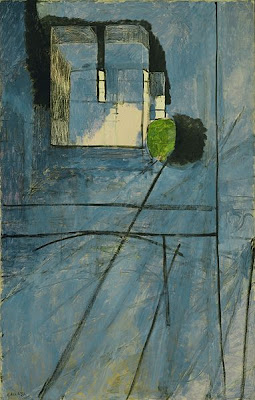
Color Field painting is a style of abstract painting that emerged in New York City during the 1940s and 1950s. It was inspired by European modernism and closely related to Abstract Expressionism, while many of its notable early proponents were among the pioneering Abstract Expressionists. Color Field painting is characterized primarily by large fields of flat, solid color spread across or stained into the canvas; creating areas of unbroken surface and a flat picture plane. The movement places less emphasis on gesture, brushstrokes and action in favour of an overall consistency of form and process.
During the late 1950s and 1960s, Color field painters emerged in Great Britain, Canada, Washington, DC. and the West Coast of the United States using formats of stripes, targets, simple geometric patterns and references to landscape imagery and to nature.
Color Field painting is related to Post-painterly abstraction, Suprematism, Abstract Expressionism, Hard-edge painting and Lyrical Abstraction. It initially referred to a particular type of abstract expressionism, especially the work of Mark Rothko, Clyfford Still, Barnett Newman, Robert Motherwell, Adolph Gottlieb and several series of paintings by Joan Miró. Art critic Clement Greenberg perceived Color Field painting as related to but different from Action painting.
An important distinction that made color field painting different from abstract expression was the paint handling. The most basic fundamental defining technique of painting is application of paint and the color field painters revolutionized the way paint could be effectively applied.
Color Field painting sought to rid art of superfluous rhetoric. Artists like Barnett Newman, Mark Rothko, Clyfford Still, Adolph Gottlieb, Morris Louis, Jules Olitski, Kenneth Noland, Friedel Dzubas, and Frank Stella, and others often used greatly reduced formats, with drawing essentially simplified to repetitive and regulated systems, basic references to nature, and a highly articulated and psychological use of color. In general these artists eliminated overt recognizable imagery in favor of abstraction. Certain artists quoted references to past or present art, but in general color field painting presents abstraction as an end in itself. In pursuing this direction of modern art, these artists wanted to present each painting as one unified, cohesive, monolithic image often within series' of related types.
In distinction to the emotional energy and gestural surface marks and paint handling of Abstract Expressionists such as Jackson Pollock and Willem de Kooning, Color Field painting initially appeared to be cool and austere. Color field painters efface the individual mark in favor of large, flat, stained and soaked areas of color, considered to be the essential nature of visual abstraction along with the actual shape of the canvas, which Frank Stella in particular achieved in unusual ways with combinations of curved and straight edges. However, Color Field painting has proven to be both sensual and deeply expressive albeit in a different way from gestural Abstract expressionism. Denying connection to Abstract Expressionism or any other Art Movement Mark Rothko spoke clearly about his paintings in 1956:
I am not an abstractionist ... I am not interested in the relationship of color or form or anything else. ... I'm interested only in expressing basic human emotions — tragedy, ecstasy, doom and so on — and the fact that a lot of people break down and cry when confronted with my pictures show that I communicate those basic human emotions. ... The people who weep before my pictures are having the same religious experience I had when I painted them. And if you, as you say, are moved only by their color relationships, then you miss the point"





